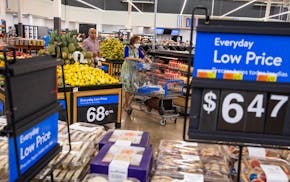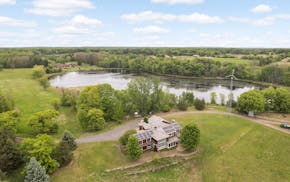Whitney Place didn't grow up on a farm, but the Okabena, Minn., native was never far from one as a kid.
"Our family lived in town, but both sets of grandparents had farms," said Place, who was recently appointed executive director of Minnesota's Farm Service Agency (FSA), the top U.S. Department of Agriculture job in the state.
A nearly 10-year veteran of the state's Agriculture Department who rose to the post of assistant commissioner, Place, 33, was tapped for the new role by the Biden administration — one of 51 FSA directors in the U.S. and Puerto Rico.
Recently, she spoke to the Star Tribune for a few minutes about the agency's role in Minnesota and her plans for it.
Q: Can you tell me about the Farm Service Agency's work and what your role will be?
A: The executive director administers the FSA's programs in the state. We have employees who are out servicing agriculture in every corner of the state — 72 service centers in all, statewide. And what we really are is the front line for administering federal farm bill programs in Minnesota. Basically, the line for farmers is, you need something, check with the FSA office. So whether that's loan programs or programs related to the pandemic, or to this year's drought — I'm the line from the administration and the USDA to the delivery of their programs in Minnesota.
Q: Any expectations from the USDA as to what your emphasis will be, or your own thoughts about priorities in the job?
A: I should mention I've been in meetings with USDA now for all of one day, so I haven't heard all the talking points or top priorities yet. But first, obviously, these programs have to be delivered effectively. And I think we're going through an interesting demographic transition in agriculture, where I think we can really utilize technology better than we have, getting these programs delivered in ways that are easier for more farmers to take them on. And then, of course, when we do have a natural disaster, or disruptions like what we saw in the pandemic, we're ready to be the response to that.
Q: What about some of your own priorities?
A: A big one for me is to try to work toward a future where everyone is welcome to participate and has access to our programs in agriculture, especially underrepresented groups like BIPOC (Black, Indigenous, people of color) farmers and women farmers. I think we're doing better, but there are stories of people being turned away at FSA offices, of certain types of farmers not being taken seriously, and I want to work really hard to make sure everyone feels welcome. Minnesota is a pilot state for an urban agriculture committee of the FSA. There's more we can do with agriculture in urban areas, and I'm excited for that. And, then, a main one: I have a background in environmental policy, and we administer the Conservation Reserve Program and the Conservation Reserve Enhancement Program, and that's a chance to work on protecting our most vulnerable lands from erosion. This has everything to do with water quality and climate change. And I think we have a real opportunity in the next farm bill to increase the amount of acreage in conservation, and to make sure we're doing that in a way that's beneficial to farmers.
Q: Let's end with a broad one: how would you characterize the state of Minnesota's farm economy right now?
A: First, I think we all had a sigh of relief that yields didn't end up so bad from the drought [last season]. I know things turned out bad for some farmers, but across the state it looked a lot better at the end of the season than we thought it would. Prices are also looking good for this upcoming year, but then fertilizer costs are really skyrocketing. With those kinds of input costs, there are going to be real concerns. I think every year has a different flavor to it, and a different challenge, and that's why some people love farming, and why some people — well, it's why some people love farming.

Ramstad: Readers say Walmart won't be paying the ultimate price of Trump's tariffs

How Minnesota businesses can spot and prevent invoice fraud
No place for cryptocurrency in retirement portfolios

Minnesota Department of Health rescinds health worker layoffs

